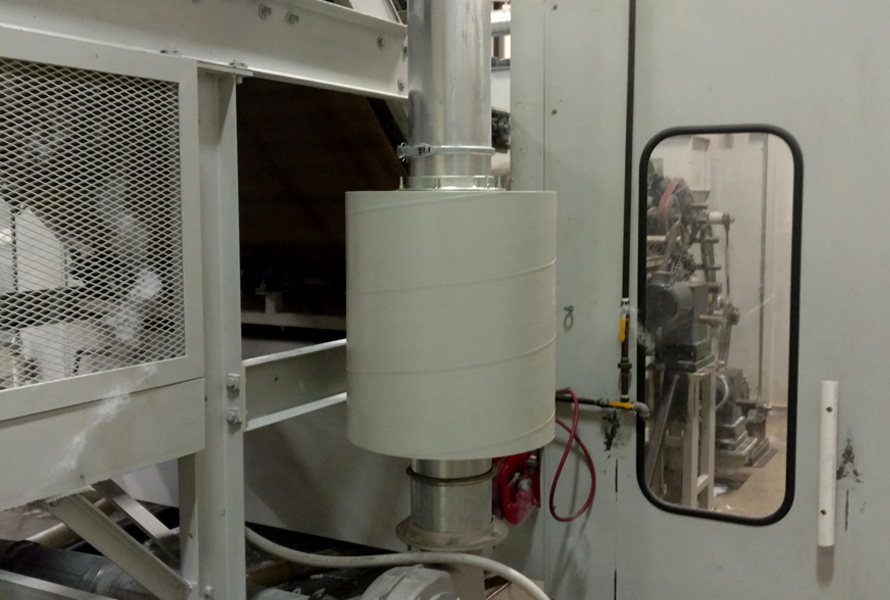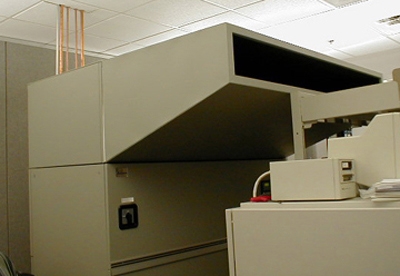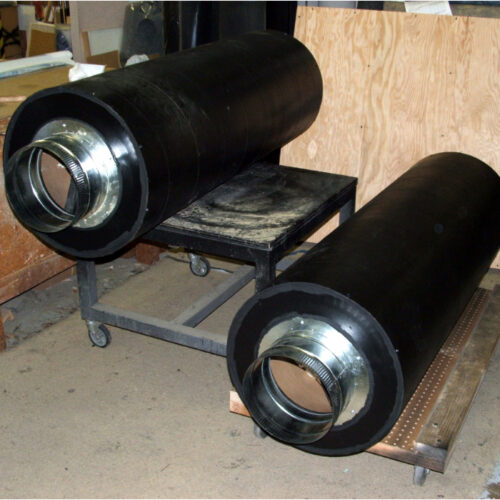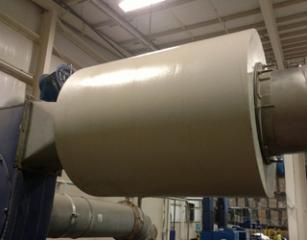HVAC Systems – Interior Ducting Silencer
One big problem with soundproofing rooms is the big hole(s) you have to cut into the walls of the room to supply fresh air or HVAC air. Sometimes the problem is that the air ducts conduct fan noise, VAV noise and turbulent air noise into the room. The same ducts can also let external noise into the room or leak sound from the room.
Home theaters, audiophile listening rooms and recording studios require quiet background noise levels. Security rooms, SCIF rooms, even holding cells all require acoustic isolating air ducts. Other applications for HVAC noise control are in condos and apartment buildings that have a common HVAC system. Counseling, doctor and lawyer offices not only value client privacy but also require HIPAA compliance.
To solve the issue of duct-borne noise leakage in all of these applications, we design and manufacture a wide variety of specialty HVAC duct silencers, from huge in-line duct mufflers to small insert baffles for retrofitting existing ductwork. Most inline mufflers are custom projects, with size constraints and noise-reduction criteria to be met, thereby requiring detailed engineering analysis and design. The small insert baffles are a standard production item, and will work to help reduce the noise transmission of nearly any HVAC system.
Additionally, we have developed many custom “air re-circulators,” serving to silently exchange air in a quiet room with the conditioned air of a neighboring room. This two-stage air handling system eliminates the need for direct HVAC lines being run into the noise or sound sensitive room while still supplying air conditioning to the quiet room.
HVAC Engineering and Design
Soundproof Openings
A hole in the wall of a soundproof room needs to be soundproofed just like the rest of the walls of the room are soundproofed. That’s what we do. We turn HVAC openings into soundproof HVAC openings. We quiet the noise coming into the room through the duct, we acoustically condition the duct so sound (break-out and break-in) does not enter or leave the duct, and finally we ensure that sound from inside the room does not get outside the room, all while we maintain a healthy circulation of air moving through the duct.
100% Open Mufflers
Most HVAC systems are low pressure systems. These have little residual back pressure with which to push air through the complex flow patterns of a small and highly efficient muffler. Unless an in-line blower is installed to boost delivery pressure, large low-head-loss mufflers must be used. Much of our work involves wide bandwidth duct silencing because of the professional and high end areas of the audio industry we serve. Our specialty is large see-through mufflers that absorb in both the bass and treble ranges and which are appropriately soundproof.

The Theory
Mufflers are like attenuating waveguides which operate in a wide frequency range. When wavelengths are long compared to the size of the muffler we use “lumped parameter” acoustic theory and when the wavelengths are short compared to the size, we use “distributed impedance” acoustic theory. It is the transition zone between these two areas that proprietary techniques, developed over many years of working with acoustics, are implemented.
Air Flow
Mufflers are intended to quiet intruding noise and not generate a new noise. Air flow must be smooth, with low surface friction so that eddy currents in the air flow are not created. In some applications adding tuned turbulence generators raises the internal noise floor inside the air duct which reduces the signal to noise ratio and improves privacy, particularly in the bass range.
Soundproofing
Sound in the ducts should not escape or break-out through mufflers and sound outside the muffler should not break-into the muffler. Flexible, flat metal ductwork and the triangle flats of round to rectangle transitions should be avoided or if used, reinforced, Sound absorbing Duct Board is very sound absorbing but not soundproof. Round metal ducts are soundproof ducts.
Frequency Range
Vocal isolation is the most common, and the frequency range is between 80 Hz and 4k Hz. For musical applications the range of 45 Hz through 12k Hz applies and for powered musical audio and recording applications, the muffler system needs to address the full audible range 20 H through 20k Hz. It is difficult and expensive to absorb low frequency sound and it is much more cost effective to let the low frequency pressure fluctuations leak it out of the duct in some area where the deep bass sound does no harm.
Accessories
A number of accessories are used in low noise HVAC projects. One of the most common is a sound absorbing air deflecting baffle plate attached in front of the opening of the duct into the room. The technique of employing a two stage HVAC system is particularly useful for very low noise applications. HVAC cools an equipment or entry room and an air recirculation system exchanges that air with the air in the quiet room. In-line booster fans are often needed. Paramount in any system is to have it balanced after all is installed. Only after balancing can the quality of the quiet achieved be evaluated.
Projects: Costs Out of Control
New Condo
Architects were doing a final inspection in preparation for the grand opening of a Main Street 5 story condo. Great attention had been paid to soundproofing the rooms from street noise but someone forgot to check the HVAC system. The architects discovered to their horror that in any unit they could clearly hear people talking in the condo across the hall. We were called for a solution that cost nearly nothing, and did not require reworking the ducts. We delivered aerodynamic shaped flow dividers that would be slipped into the first few feet of each duct, inserted by removing the grill and sliding the sound absorber units into the duct. They were built, shipped overnight and installed the next day by a maintenance crew. The grand opening went off without a hitch, and the air flow did not get choked down.
New Studio
Building studios in large warehouse spaces is getting popular these days, and so it as with our next client. After extensive attention to soundproofing and sound conditioning in all the sound sensitive rooms, wiring, window and door isolation, floor plans and visco damped constructed walls and ceilings, it was time to tape and paint. They were horrified when the HVAC was finally hooked up and turned on. Despite endless assurances from the contractor the HVAC noise levels were so high they couldn’t imagine being able to open a mic in order to record. Balancing the air didn’t make any difference. We got the panic call, because they were booked to start recording in a week. We built a set of huge soundproof in-line duct mufflers, one for each inlet or outlet of each noise sensitive room in the studio. After air balancing the HVAC became inaudible, as did vocal or instrumental cross talk between rooms, because of sound traveling through the ductwork.
High-End Audiophile Room
The audiophile likes a silent listening room so they can hear the quietest subtleties and nuances in the music and in the musical hall ambience. We were chosen to help build the room and outfit it with acoustics. This was a room inside a concrete room that was buried in the ground. It was naturally very quiet and it needed to stay that way. There was an entry hall and equipment room before you entered the room proper. All the equipment was located in the equipment room so as to not pollute the listening room with noise. We had the air conditioning dump into the machine room and added a recirculation system to take that air and circulate it into the listening room. The noise level in the machine room was pretty quiet and the in-line mufflers of the recirculation system were more than adequate to maintain silence in listening room.










